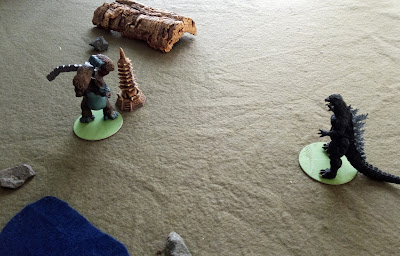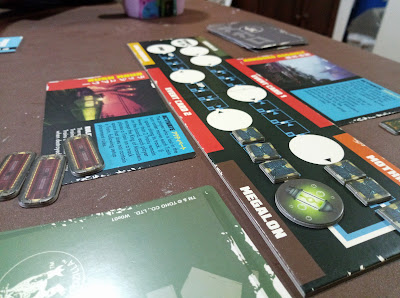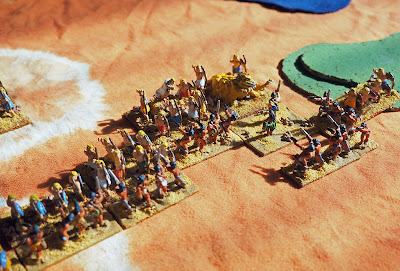The issue here really was that with two attackers the poor defender is forced to concentrate on one whilst giving the other free reign. I guess that with a player per monster, though, the two attackers would be watching each others' scores closely and would switch to fighting each other to prevent the other monster winning. But maybe not - doubling down and destroying as much property as possible would also work. Cherno Alpha was actually a tricky foe as a defender in some ways. The two attackers could fight it, but in fact it has a high toughness, so is hard to damage. Can a monster afford to spend time and energy doing that for a lower points reward than buildings would give? Or are you better off concentrating on the buildings and simply hoping the Cherno Alpha doesn't damage you too much. There's always a decision to be made in a Giant Monster Rampage.
Pages
Thursday, 29 July 2021
Godzilla vs Kong - With Added Jaeger
The issue here really was that with two attackers the poor defender is forced to concentrate on one whilst giving the other free reign. I guess that with a player per monster, though, the two attackers would be watching each others' scores closely and would switch to fighting each other to prevent the other monster winning. But maybe not - doubling down and destroying as much property as possible would also work. Cherno Alpha was actually a tricky foe as a defender in some ways. The two attackers could fight it, but in fact it has a high toughness, so is hard to damage. Can a monster afford to spend time and energy doing that for a lower points reward than buildings would give? Or are you better off concentrating on the buildings and simply hoping the Cherno Alpha doesn't damage you too much. There's always a decision to be made in a Giant Monster Rampage.
Wednesday, 28 July 2021
Godzilla vs Kong Again
I spent Monday evening re-reading it. Whilst not complicated, it is one of those 'toolkit' games with lots of optional rules dotted through the text. And, as I always do with these things, I have house-ruled it to death, so I had to find my notes on those as well.
 |
Monday, 26 July 2021
Godzilla vs Kong
(As an aside this is an issue with gladiator rules, which can easily consist of two models hacking away at each other to the point where you may as well not have them. One of the things we tried to do with 'Munera Sine Missione' was create small moves and dodges that kept the fight travelling around the arena. )
Saturday, 24 July 2021
Another Tokyo Clash
Catherine, Maya and I gave 'Godzilla: Tokyo Clash' another outing yesterday evening; a chance to try it with three monsters. Catherine and I took Mothra and Ghidorah respectively, whilst Maya took Godzilla.
Friday, 23 July 2021
Godzilla: Tokyo Clash
We're still in lockdown here, so boardgames are still proving a popular diversion. Yesterday evening Catherine and I had a go at a new purchase - 'Godzilla: Tokyo Clash'. I've fancied a giant monster boardgame for a while, but I've never been that excited by what I've read of those available. The reviews for this one, however, suggested that it was exactly what I wanted and I wasn't disappointed.
The suggested two-player starter is Godzilla vs Megalon. Mothra and Ghidorah both have abilities that require a little more understanding of how the game works, although they aren't overly complicated. Anyway, that's the pairing we set up; Catherine took Godzilla, whilst I took Megalon. The board is modular, and features large buildings, which have models, and small buildings, which are just counters. At the start of each game you select two event cards, which are in play throughout. These add vehicles or other tokens to the board which can help or hinder the monsters. In our game we had trains (which can be destroyed to gain energy) and tanks (which home in on monsters and damage them).
And that's what happened here - the marker moves at the start of the turn, so you always play the last turn.
And that's how the last turn panned out, We both spent the early part grabbing what little energy there was left, and engaged in some brief close combat. I backed off, having no energy left. Catherine launched one of Godzilla's heat ray attacks, and inflicted damage on me. However I blocked some of the damage with a deflection move which allowed me to destroy a nearby building. And that gave me enough energy to retaliate with a ranged attack of my own. I damaged Godzilla, and took the King of the Monsters token from him.
Anyway, if you like giant monsters, and especially if you like your classic Godzilla, this is a game for you.
Sunday, 18 July 2021
Spinnaker
Catherine and I tried another race-themed boardgame this afternoon. Swapping bicycle for yachts we played 'Spinnaker'*, a game which appears to have been produced here in Australia around 1980**. Maya found a copy of it in the charity shop they volunteer in, and bought it for me for the princely sum of $3.
Of course it has the vital selling-point of nice plastic pieces; in this case little yachts, with detachable spinnakers. Sadly my copy of the game is missing spinnakers for two of the yachts, but they should be easy to make from craft-paper.
The board is a square-grid, and yachts can move orthogonally or diagonally. Movement is determined by the wind direction, obviously. Winds can be light (offering 1 or 2 movement points) or strong (offering 1-4 movement points). A yacht must move in a straight line based on its facing at the start of the turn, but can use a movement point to change facing to any direction at the end of its move. You can opt to spend points to raise the spinnaker, which doubles your movement points, although the spinnaker must be lowered in certain wind aspects. Here's the four yachts in our second game all heading west with spinnakers deployed.
Anyway, we enjoyed this game, and will probably get it out again.
* According to BGG, there are two games called 'Spinnaker'. This is not the 1985 version from Overlay Games.
** There's a small note on the box saying that if you have any questions about the rules to send a stamped, addressed envelope to a particular residential address. It's actually less than ten minutes from my house. But I suspect that after 40 years the unnamed designer has long gone.
Saturday, 17 July 2021
Lothar vs Helium
I had a comment that I'd never properly posted a game featuring my Bowmen of Lothar Barsoomian army, so I played a game today. They took on the winners of the previous battle - Helium.
The Bowmen of Lothar are a tricky army, since they are illusionary. When I originally designed them I ran them as hordes, since there are effectively limitless numbers of them, but it didn't really do their deadly archery any justice at all, so I switched them to shooters, but with a couple of hordes to allow them to stave off defeat by bringing back troops. They are also the only Barsoomian army to feature a magician, since they are controlled, indeed summoned, by the mental powers of one or two individuals.
Helium defended, and limited the amount of bad going available. With shooters and beasts (very real banths, or Martian lions) Lothar likes a bit of bad going, whilst Helium's arm is equipped for fighting in the open.
Here they are at the start of the game.
Helium hedged their bets, putting out a long line of blades, and aerials on both ends. The aerials would have to be careful of Lothar's strong missile capabilities. And both they, and John Carter, would have to take care of Lothar's magician general.
Both armies advanced cautiously, adjusting their lines as they did.
Helium won 15g-5
I played a second game (unphotographed) in which Lothar defended. They limited Helium's opening moves with a series of woods, ambushed their advancing blades with banth attacks and before Helium could organise their army properly, ensorcelled John Carter to win the battle.

























































